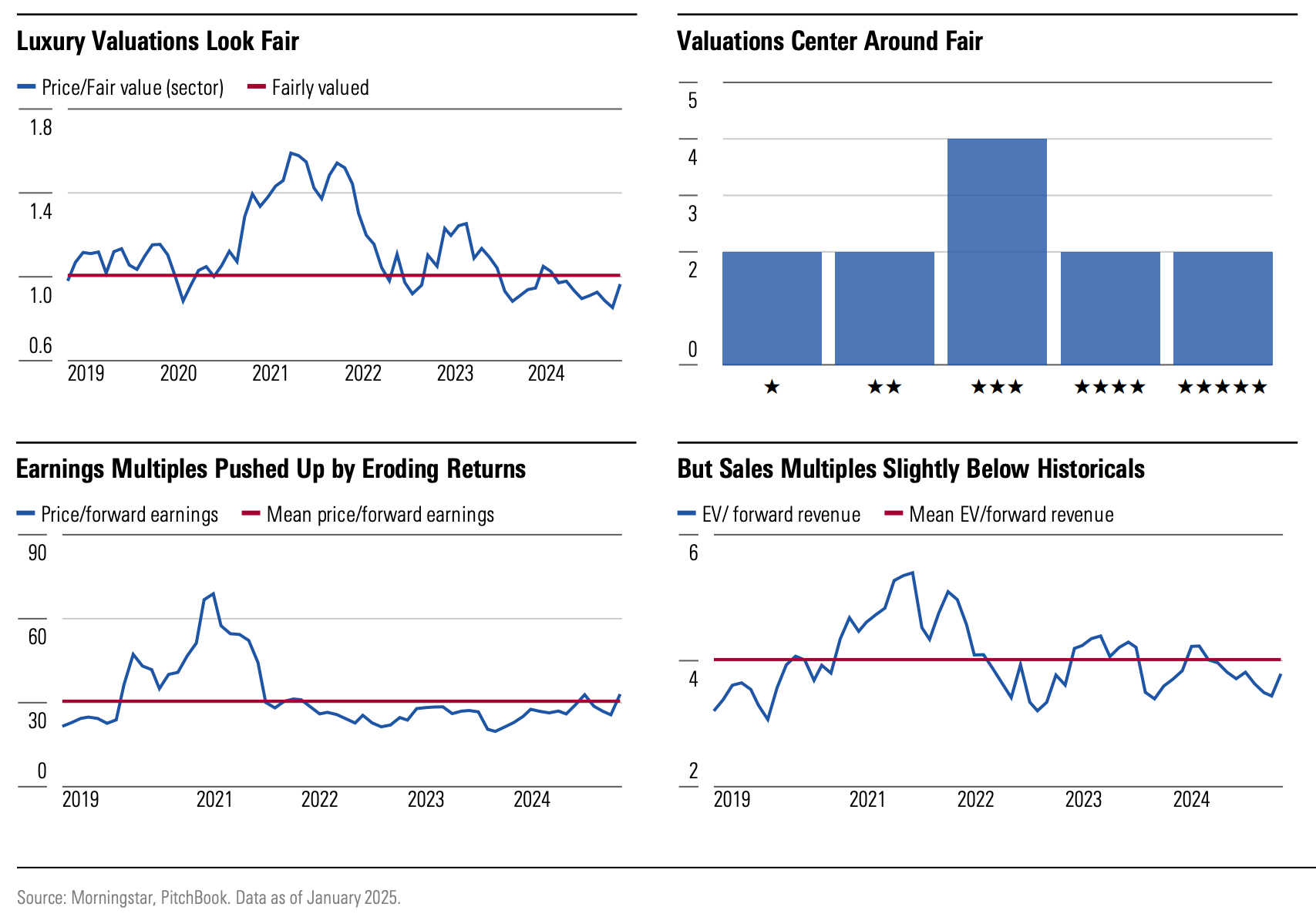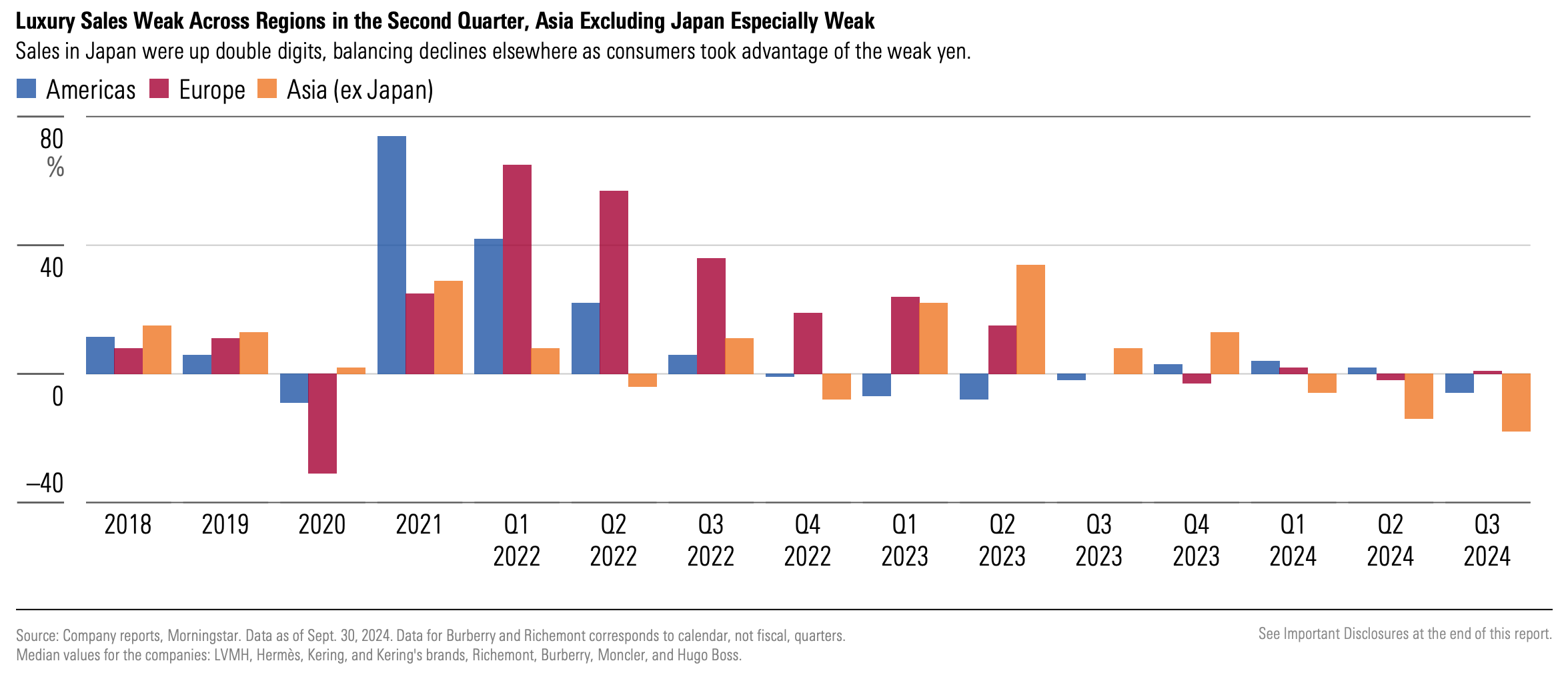4 min read
Is the Luxury Goods Market a Good Investment? Here’s the Latest Data
The luxury sector is largely fairly valued at this point, with few instances of overvaluation and undervaluation.

Key Takeaways
The luxury sector is experiencing a cyclical downturn, characterized by sales and margin pressures.
Demand in the West remains weak, while recovery in Chinese consumption is faltering.
Luxury brands are grappling with accelerating cost increases, impacting their margins.
Despite the challenges, opportunities exist within specific luxury companies: Kering, Swatch, Burberry, Hugo Boss, and Capri.
While the luxury goods sector is complex, it also offers opportunities for those willing to navigate its nuances. In the words of Warren Buffet, "Price is what you pay. Value is what you get."
Understanding market trends, key drivers, and valuations is essential for financial advisors and asset managers who want to help their clients make sound investment decisions.
Explore the intricate landscape of the luxury sector with our consolidated "Luxury Goods Industry Pulse" Q4 2024 report. This comprehensive analysis provides detailed insights into revenue and cost trends, challenges such as subdued demand, rising costs, and margin pressures, as well as the unfolding opportunities within the industry. Discover the potential within renowned brands like Kering, Swatch, Burberry, Hugo Boss, and Capri while gaining a clear understanding of overvaluation and undervaluation areas and the evolving influence of inflation and supply chain bottlenecks from pandemic times.
To read the full research report, download a copy.
A Closer Look at Luxury Valuations
According to the latest expert analysis, luxury valuations experienced a bounce back at the end of the year. In a similar vein, apparel companies – both luxury apparel brands and more accessible brands – who benefited from stimulus spending and economic recovery from 2021 onward have still faced several challenges which subsequently produced inconsistent results and compressed valuations. Where do other luxury brands stand in the crowd?
The luxury sector is largely fairly valued at this point, with few instances of overvaluation and undervaluation. One of the significant findings in this area is the rise in earnings multiples due to eroding returns. In contrast, the sales multiples are lagging slightly behind the historical data.

Luxury valuations are looking fair, but sales multiples are still slightly below historical data.
At present, our evaluation frames the sector as predominantly balanced in terms of value, though there are areas of both overvaluation and undervaluation. We anticipate that the current cyclical dip in demand will not persist for an extended period. Drawing from the past 30 years of industry data, decreased demand hasn't exceeded a two-year period. The recent surge in optimism due to economic stimulus, stabilizing property prices in China, and US growth has lifted investor expectations, presenting appealing opportunities within the sector.
Investment Opportunities for Luxury Brands: What are the Top Picks?
The most recent research on luxury brands pinpoints some undervalued names in the luxury sector, including Kering, Swatch, Burberry, Hugo Boss, and Capri. But as far as what investors may be interested in specifically from each of these brands, there are three key product areas to explore:
Luxury Leather Goods
Luxury Watches
Luxury Apparel
Clocking in at the second-largest luxury group based on their revenue, it might be a good time to find opportunities related to luxury leather goods with the Kering brand. Despite its popular flagship brand, Gucci, experiencing slower momentum, the brand has access to extensive marketing resources, over 90% control of its distribution, and well-established name recognition. They are a competitive option in the luxury goods sector with a high rating and fair valuation.

Even though its previous performance was lacking, Burberry merits from high brand recognition, pricing power, and strong distribution control.
Luxury apparel brings even more options as far as branding goes, with names like Burberry and Capri taking center stage. Capri in particular has a potentially interesting future. Due to previously disappointing performance following a failed acquisition in 2023, plus issues with distribution and merchandising, its value has been overlooked by investors. However, Morningstar analysts predict upcoming opportunities as the company works on pricing changes and cost cuts, which may make it an appealing acquisition by other luxury houses, such as Versace or Jimmy Choo.
Another area of the luxury market to consider is luxury watches. This industry has seen steady growth over the years, with consumers willing to invest in high-quality timepieces as a symbol of wealth and status. Brands like Swatch and Rolex dominate this sector with their reputation for precision, craftsmanship, and exclusivity.
Luxury Sales Trends: A Mixed Bag
Taking a closer look at luxury sales trends, it's evident that there are regional nuances. While the third quarter of 2024 saw a decline in sales for many players in the luxury market, there were pockets of growth. Sales in the Americas and Europe have seen a marginal increase, providing a silver lining amid the generally weak performance.

Over the last 4 years, luxury sales have progressively weakened across the Americas, Europe, and Asia (excluding Japan).
The Q3 2024 data revealed a weakening in luxury sales across all regions. A particularly noticeable dip was seen in Asia, excluding Japan. Despite slight improvements, the sales in the Americas and Europe remained underwhelming, especially after the post-COVID rally. A fluctuating recovery in Chinese consumption also impacted luxury sales in the region.
The Impact of Rising Costs in the Luxury Sector
In addition to shifting sales trends, rising costs have added to the challenges faced within the luxury goods sector. Increases have been witnessed notably in rental costs and raw material prices, such as gold and silver. These escalating operating costs pose a challenge to maintaining margins for luxury firms. The inflation in rental costs has been more pronounced in European capitals and Tokyo, subsequently impacting the profitability of the luxury sector.

Since a large share of rental and sales personnel costs are fixed (50%-70%), weakness in the top line in 2024 is expected to lead to margin pressures on fixed-cost under-absorption.
Empowering Smart Decisions in the Luxury Sector
Every industry experiences global economic shifts, and the luxury goods sector is no exception. Sales and margins have been under pressure due to declining luxury consumption. This in turn has led to an increase in fixed costs. However, even in this challenging climate, the sector remains fairly valued, suggesting potential for careful investors. Armed with this data, financial advisors and asset managers can help clients make informed investment decisions.
Despite the apparent obstacles, recent data shows that there are still investment opportunities in the luxury sector. Brands like Kering, Swatch, Burberry, Hugo Boss, and Capri Holdings are currently undervalued, presenting attractive opportunities for discerning investors. These companies, with their varying market caps, moat ratings, and uncertainty ratings, offer diversified investment options within the luxury goods sector.
Discover the power of precise data with PitchBook. Designed for financial advisors, asset managers, and individual investors, our platform provides a deep dive into the luxury goods sector, offering valuable insights, thorough research, and the most reliable market data. Whether you're tracking an emerging brand's growth or analyzing market volatility, PitchBook empowers you to make informed decisions. Expand your knowledge and master the nuances of the luxury goods sector with PitchBook.